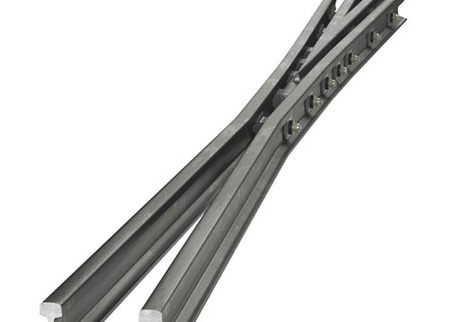Volver a la información general
Built-Up Crossing EHZ COMPACT 1400
Common Built-up Crossing "EHZ COMPACT 1400".
Volver a la información general
Common Built-up Crossing "EHZ COMPACT 1400".

This design consists of a crossing vee, which is machined out of a rolled slabe made of tempered steel. The closure rails are connected to the vee by blash butt welding. The two wing rails are also made out of standard rail profile,, machined and bolted by means of distance blocks to the welded crossing vee.
Technical description:
The crossing vee is machined from a rolled slab made of tempered steel. The length of the crossing vee depends on the rail profile and the geometry of the crossing. The welding joint between crossing vee and closure rails is in any case in the area where the wheel overrun of wing rail/crossing vee is completed. Distance blocks are welded onto the crossing vee. The closure rails are machined from rolled rail profiles. They are welded together in the area of the head and foot and connected to the crossing vee by means of flash-butt welding. The wing rails are also made from rolled rail profiles, machined and bolted to the welded crossing vee by means of distance blocks. All distance blocks are machined and adjusted to the support areas of the closure and wing rails during final assembly. This guarantees on the one hand an exact position of the distance blocks and on the other hand adherence to the required flange way tolerances.
Bolting of the Crossing "High-Tensile"
This type of bolting is used for durably connecting the main components (wing rail, crossing vee, closure rail, guard rail and joggled rail) of common, obtuse and multiple built-up crossings.
The components are connected to each other by means of high-tensile metric bolts (property class 8.8 or 10.9) and hexagon nuts. In order to make sure that the seat of the rail head and the hexagon nut is level, special shims are used. These shims have a special form in the contact area of the rail web so that the best possible contact surface is achieved. Possible settling loss can thus be kept to a minimum. To achieve the rectangular contact of the head of the bolt and the nut, hardened spherical disks and ball sockets are used. They guarantee a 100% rectangular contact area of the head of the bolt and the nut. Self-locking nuts are used to make sure that the bolt does not get loose.